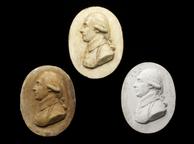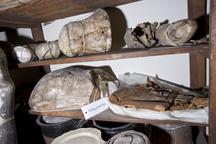

Ink drawing, “Perpendicular Axis for Reducing Machine "
- Made:
- 1809
Drawing. Ink drawing and annotations with some pencil alterations and further annotations. Arranged along one short side, 1 view and 2 scrap views: “Perpendicular Axis for Reducing Machine / Drawn to full size Apl 8th 1809”. Long note: “The fault of this construction …”. Over most of the sheet, having been turned around, “Drawing of paralel (sic) Machine with Sliding Motion. The frames of hollow Iron tubes. finished Apl 14 1809”. Front elevation showing cross-rail, feed screw and pendant frames, and details. 6 details in ink, and a further incomplete one in pencil. These frames and NOT the light tubular ones of tinplate now fitted. A note reads: “July 12th NB all the tubes … to be … [&c.]” That is, the arrangement had not then been constructed. (check size) 21 7/8" x 17 3/8", watermark J WHATMAN / 1805.
This item is part of the contents of the workshop that Scottish engineer James Watt developed at his home, Heathfield, at Handsworth, Birmingham, from c.1795 through to his death in 1819. Although Watt is best known for his work on the steam engine, his workshop contains a wide variety of objects from many different projects, from chemistry to sculpture-copying.
This drawing is one of a set made by Watt during his time in the workshop. They include detail from how to mount a diamond on the end of a wire, to designs for weighing machines, to the construction of the lathe bench present in the workshop. However, the majority concern Watt’s work on his sculpture copying machines, both resident in the workshop. They show how their design evolved over time, including details of framing, feed mechanisms, drill frames and more. These were Watt’s major project in the workshop, and provide us with dates for some of the component parts of the machines stored around the room.
Details
- Category:
- James Watt's Garret Workshop
- Object Number:
- 1924-792/423/33
- Materials:
- paper
- type:
- drawing




